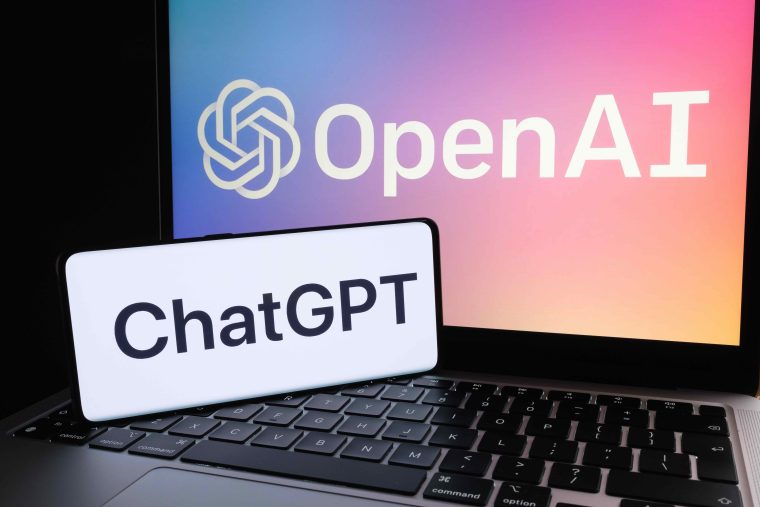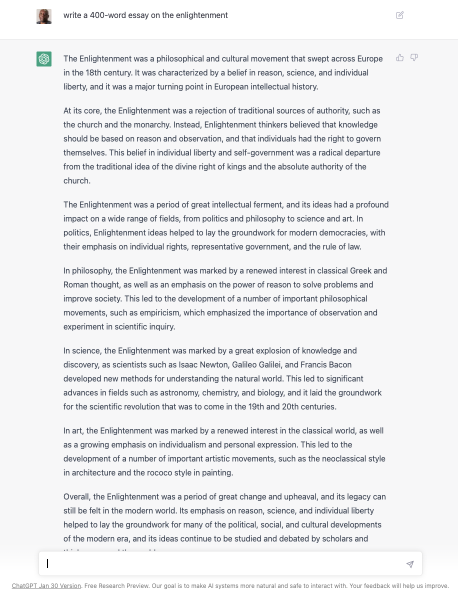
Everyone is talking about ChatGPT and we have compiled the top 100 statistics everyone needs to know about the internet sensation. That’s not surprising as ChatGPT is the fastest-growing app in history.
ChatGPT is the new artificial intelligence chatbot from OpenAI that has captured the public imagination.
The chatbot is being hailed as the most exciting thing that has happened in technology since the advent of the internet and the first search engine or the launch of the iPhone.
For sure, there’s been a lot of hype, but it may well be justified. ChatGPT can answer queries in 95 languages in a human-like conversational style, learning from your responses as it goes.
Ask any question and it will be able to provide a text response, although as we see in our 100 top ChatGPT statistics below, there are limitations.
Ask ChatGPT to write a 400-word assignment on The Enlightenment and it will do that:
Fancy a trip to the stores to buy some clothes? It will provide you with the relevant list of retail outlets.
Struggling with javascript for a web page you are coding – ask the right query and ChatGPT will generate the code for you.
Because ChatGPT is so human-like in its comprehensive and mostly accurate answers, it threatens to do away with search engines, or at least to force a radical reimagining of them.
Google and a host of other tech companies are racing to catch up with OpenAI, but for now it is ChatGPT that is the fastest-growing app ever.
If you haven’t used ChatGPT yet, set up an account and get started here: https://chat.openai.com/chat
And if you want to find out everything there is to know about ChatGPT in 1,800 words, read on.
What is ChatGPT?
1. ChatGPT is an artificial intelligence (AI) chatbot – a conversational AI system.
2. GPT stands for Generative Pre-trained Transformer. GPT is a Language Model.
3. ChatGPT is a form of Generative AI – Generative AI refers to computer generation of text or images as a response to human input.
4. ChatGPT makes use of the Transformer model – a neural network that learns contextual information. Transformer was originally developed by Google Labs in 2017.
5. GPT and other language models are “trained” using Machine Learning (ML).
6. Language models like GPT use statistical and probabilistic techniques to predict the next word in a sentence based on the previous sentence or words.
A language model establishes the chances – probability distribution – of the next word being “valid”, valid in the sense that it resembles a sentence a human being would write.
7. The GPT language model generates relevant text in response to “system prompts” in the form of human-written questions.
8. Machine-learning refers to a computational tool for efficiently incorporating vast amounts of data that is reusable “out of sample”. In other words the data being consumed is not the data that was used to train the model in the first instance, hence “out of sample”.
9. This form of language modeling is known as an Autoregressive Language Model for deep learning.
10. Language models “learn” (through the training process) by consuming vast amounts of data.
11. Natural Language Processing (NLP), Natural Language Generation (NLG) and machine learning are all used to create and refine language models such as GPT.
12. ChatGPT uses Reinforcement Learning From Human Feedback (RLHF) to train the GPT language model. An initial model was trained using Supervised Fine-Tuning (SFT), where AI Trainers interact with the model directly as both user and AI assistant.
AI trainers ranked the conversations and this was further refined in an iterative process known as Proximal Policy Optimization (PPO), as shown in the infographic below:
13. ChatGPT and the GPT 3.5 language model it is based on were trained on an Azure AI supercomputing infrastructure. Azure is owned by Microsoft.
14. Azure provides the operating infrastructure for ChatGPT.
Essential statistics about OpenAI
15. OpenAI was founded in San Francisco, California, as a non-profit organization in 2015 with the mission, as embodied in the OpenAI Charter, to create “safe and beneficial” AGI.
16. ChatGPT is developed by OpenAI.
17. OpenAI was founded by Carlos Virella, Elon Musk, Greg Brockman, Ilya Sutskever, James Greene, Sam Altman and Wojciech Zaremba.
18. OpenAI’s mission is to make computers think like humans – Artificial General Intelligence (AGI).
19. Here is an excerpt from the opening paragraph of the OpenAI charter:
OpenAI’s mission is to ensure that artificial general intelligence (AGI)—by which we mean highly autonomous systems that outperform humans at most economically valuable work—benefits all of humanity.
We will attempt to directly build safe and beneficial AGI, but will also consider our mission fulfilled if our work aids others to achieve this outcome.
20. Early board members included tech entrepreneurs Peter Thiel and Elon Musk. Elon Musk left the board in 2018 but remained a donor.
21. Elon Musk has distanced himself from OpenAI after criticizing Microsoft’s involvement.
22. In 2019 OpenAI became a profit-making enterprise (Open AI LP), controlled by the board of the original non-profit organization (OpenAI Inc).
23 GPT technology was first revealed to the public on 14 February 2019 as open source and known as GPT2, but requiring a proprietary license.
24. Other notable OpenAI technology includes DALL.E 2 – generates images from a text description.
25. ChatGPT is developing Point-E – software to develop 3D models from simple word prompts.
ChatGPT statistics
26. ChatGPT was launched on 30 November 2022 and is the fastest-growing app ever.
27. ChatGPT launched using the GPT 3.5 language model.
28. In December 2023 ChatGPT had 57 million users according to estimates by UBS analyst Lloyd Walmsley in a research note published on 1 February 2023, as reported by Barron’s.
29. In January 2023 ChatGPT was estimated to have 100 million users.
30. ChatGPT has reached 100m users in two months. By comparison it took TikTok nine months to reach 100 million users and Instagram 2.5 years.
31. In January 2023 ChatGPT had 672 million web visits, according to Similarweb.
32. ChatGPT averaged more than 13 million daily visitors in January 2023.
Investors in ChatGPT developed and owner OpenAI
33. In 2015 OpenAI raised $1 billion from investors.
34. Venture capital investors: Y Combinator; Reid Hoffman Association; Khosla Ventures; Matthew Brown Companies; Microsoft; Tiger Global Management; Andreessen Horowitz; Sequoia Capital; Bedrock Capital; Infosys; Jesica Livingston; Peter Thiel; Amazon Web Services (last three not included in table – source dealroom.co).
OpenAI early investors
35. Microsoft invested $1 billion in OpenAI in July 2019. It also joined a funding round in 2021.
36. On 23 January 2023 Microsoft announced it was investing a further $10 billion in OpenAI.
37. OpenAI CEO is Sam Altman (former president of Y Combinator, a seed round investor in OpenAI).
38. OpenAI President Greg Brockman.
39. OpenAI CTO Mira Murati.
40. OpenAI latest valuation: $29 billion.
Some of the things ChatGPT can do
41. Answer queries with a textual response in 95 languages.
42. Remember what users said earlier in the conversation.
43. Allows users to provide follow-up corrections.
44. Trained to decline inappropriate requests.
45. Write school assignments and essays.
46. Write code.
47. Pass an MBA.
48. Write a funny story.
49. Write a limerick.
50. Write a resignation letter to your employer.
51. Generate shopping lists for meals.
52. Create a list of the nearest Korean restaurants to you.
53. Bing helps ChatGPT do more. Bing uses Prometheus to deliver answers on events after 2021.
54. Microsoft’s Edge browser in consort with ChatGPT can, for example, instantly summarize the financial results of any two companies, compare them and generate key takeaways.
ChatGPT has limitations
55. Not very good at logical reasoning.
Here’s an example of a ChatCGT fail:
Not too soon. Look at some epic Chat GPT fails. Any human can answer this. pic.twitter.com/qfiga2sS3L
— Strangeloop (@neuro_tarun) December 1, 2022
56. May occasionally generate incorrect information – could be a growing source of misinformation.
57. Sometimes ChatGPT is inaccessible because of load on servers, so. you may see a “busy” message, or more recently a message like this: “We’re experiencing exceptionally high demand. Please hang tight as we work on scaling our systems.”
58. May occasionally produce harmful instructions or biased content.
59. Limited knowledge of world and events after 2021.
60. Not very good at math puzzles and brain teasers.
61. ChatGPT is not infallible so will get some things wrong.
62. Could infringe copyright.
63. Can lead to ‘hallucination’ – gives convincing yet wholly fictitious answers.
64. Cannot be relied upon for serious work (yet).
65. ChatGPT-powered Microsoft Bing search engine and Microsoft Edge web browser are for now only available on desktop.
More ChatGPT stats
66. Only answers questions on world affairs and events prior to 2021.
67. How much does answering a ChatGPT query cost on average? $0.36.
68. Each word generated by ChatGPT costs $0.0003.
69. Paid version of ChatGPT Pro costs $20/month.
70. ChatGPT is available in 161 countries, regions and territories.
71. ChatGPT is not available in China, Iran, North Korea, Russia, Venezuela and Belarus.
These could be the ChatGPT losers
72. All types of language and knowledge-based workers.
73. Publishers that rely on traffic from google links because if Bing/Edge powered by ChatGPT provides fuller answers in plain English text there’s no need to visit a site to receive less contextualized answers.
74. All manner of professionals and specialists.
75. Writers.
76. Educationalists.
77. Advertisers that rely on search engine results pages composed of links might find their ad links more difficult to place and still be as clickable.
78. Basic computer programmers.
79. Google.
“After I turn in this column, I’m going to do something I thought I’d never do: I’m switching my desktop computer’s default search engine to Bing.”
Kevin Roose, New York Times
ChatGPT’s AI chatbot competitors
80. Google AI chatbot Bard. Introduced to the public at a demonstration on 6 February.
Among other things, Bard was asked: “What new discoveries from the James Webb Space Telescope can I tell my 9 year old about?”
One of Bard’s three bullet-pointed answers was incorrect when it claimed, incorrectly, that the James Webb Space Telescope “took the very first pictures of a planet outside of our own solar system.”
Google uses the LaMDA language model.
81. LaMDA differs from GPT by being trained on dialogue as opposed to web text. LaMDA stands for Language Model of Dialogue Applications. Like GPT, LaMDA is a Large Language Model (LLM).
These are the main LLMs:
82. Turing NLG (Microsoft).
83. Gopher, Chichilla (Deepmind).
84. Switch transformer, GLAM, PALM, LaMDA, T5, MT5 (Google).
85. OPT, Fairseq Dense (Meta).
86. GPT-3 versions such as GPT-Neo, GPT-J, & GPT-NeoX (Open-AI).
87. Ernie 3.0 (Baidu).
88. Jurassic (AI21Labs).
89. Exaone (LG).
90. China’s Baidu could be the major ChatGPT.
91. Baidu is launching its AI chat service in March.
In 2019 Baidu’s AI Chat scored 90.1 on the General Language Understanding Evaluation benchmark ERNIE model score. Its score beat Microsoft’s MT-DNN-SMART and Google’s TS models.
92. According to reports, Baidu’s ChatGPT AI chatbot will be called Ernie Bot.
93. Kunlun Tech says it will have its own version of a ChatGPT-like AI chatbot.
94. Other China-based competitors include: Alibaba, Tencent, NetEase, Kuaishou Technology, Inspur Electronic Information Industry, 360 Security Technology, Kunlun Tech and JD.com.
The ethics of generative AI and ChatGPT
95. New York City education department has banned ChatGPT.
96. A poorly trained AI chatbot can replicate societal biases
Microsoft’s Tay bot deployed on Twitter was withdrawn after generating sexist, racist and abusive language responses.
97. Lack of a system for disclosing when a response has been generated by an AI chatbot.
98. Generally, AI chatbot data usage, ownership and protection is not transparent.
99. Generally, there’s a need to guard against commercial bias built into the chatbot model to benefit certain companies.
100. Chatbot personas have traditionally been female, for example Amazon’s voice chatbot Alexa, but should they be gender neutral?
